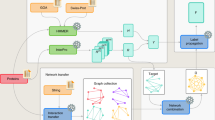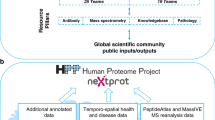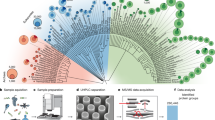Abstract
Genome sequencing projects have provided researchers with an unprecedented boon of molecular information that promises to revolutionize our understanding of life and lead to new treatments of its disorders. However, genome sequences alone offer only limited insights into the biochemical pathways that determine cell and tissue function. These complex metabolic and signaling networks are largely mediated by proteins. The vast number of uncharacterized proteins found in prokaryotic and eukaroyotic systems suggests that our knowledge of cellular biochemistry is far from complete. Here, we highlight a new breed of 'postgenomic' methods that aim to assign functions to proteins through the integrated application of chemical and biological techniques.
This is a preview of subscription content, access via your institution
Access options
Subscribe to this journal
Receive 12 print issues and online access
$259.00 per year
only $21.58 per issue
Buy this article
- Purchase on Springer Link
- Instant access to full article PDF
Prices may be subject to local taxes which are calculated during checkout






Similar content being viewed by others
References
Gerlt, J.A. & Babbitt, P.C. Divergent evolution of enzymatic function: mechanistically diverse superfamilies and functionally distinct suprafamilies. Annu. Rev. Biochem. 70, 209–246 (2001).
Walsh, C.T. Posttranslational Modification of Proteins. Expanding Nature's Inventory (Roberts & Company, Greenwood Village, Colorado, USA, 2005).
Austin, C.P. et al. The knockout mouse project. Nat. Genet. 36, 921–924 (2004).
Carpenter, A.E. & Sabatini, D.M. Systematic genome-wide screens of gene function. Nat. Rev. Genet. 5, 11–22 (2004).
Clardy, J. & Walsh, C. Lessons from natural molecules. Nature 432, 829–837 (2004).
Gerlt, J.A. & Raushel, F.M. Evolution of function in (β/α)8-barrel enzymes. Curr. Opin. Chem. Biol. 7, 252–264 (2003).
Neidhart, D.J., Kenyon, G.L., Gerlt, J.A. & Petsko, G.A. Mandelate racemase and muconate lactonizing enzyme are mechanistically distinct and structurally homologous. Nature 347, 692–694 (1990).
Osterman, A. & Overbeek, R. Missing genes in metabolic pathways: a comparative genomics approach. Curr. Opin. Chem. Biol. 7, 238–251 (2003).
Schmidt, D.M., Hubbard, B.K. & Gerlt, J.A. Evolution of enzymatic activities in the enolase superfamily: functional assignment of unknown proteins in Bacillus subtilis and Escherichia coli as L-Ala-D/L-Glu epimerases. Biochemistry 40, 15707–15715 (2001).
Wise, E., Yew, W.S., Babbitt, P.C., Gerlt, J.A. & Rayment, I. Homologous (β/α)8-barrel enzymes that catalyze unrelated reactions: orotidine 5′-monophosphate decarboxylase and 3-keto-L-gulonate 6-phosphate decarboxylase. Biochemistry 41, 3861–3869 (2002).
Wang, S.C., Person, M.D., Johnson, W.H., Jr & Whitman, C.P. Reactions of trans-3-chloroacrylic acid dehalogenase with acetylene substrates: consequences of and evidence for a hydration reaction. Biochemistry 42, 8762–8773 (2003).
de Jong, R.M., Brugman, W., Poelarends, G.J., Whitman, C.P. & Dijkstra, B.W. The X-ray structure of trans-3-chloroacrylic acid dehalogenase reveals a novel hydration mechanism in the tautomerase superfamily. J. Biol. Chem. 279, 11546–11552 (2004).
Mizanur, R.M., Jaipuri, F.A. & Pohl, N.L. One-step synthesis of labeled sugar nucleotides for protein O-GlcNAc modification studies by chemical function analysis of an archaeal protein. J. Am. Chem. Soc. 127, 836–837 (2005).
Kurnasov, O. et al. NAD biosynthesis: identification of the tryptophan to quinolinate pathway in bacteria. Chem. Biol. 10, 1195–1204 (2003).
Zhuang, Z., Gartemann, K.H., Eichenlaub, R. & Dunaway-Mariano, D. Characterization of the 4-hydroxybenzoyl-coenzyme A thioesterase from Arthrobacter sp. strain SU. Appl. Environ. Microbiol. 69, 2707–2711 (2003).
Patterson, S.D. & Aebersold, R. Proteomics: the first decade and beyond. Nat. Genet. 33, 311–323 (2003).
de Hoog, C.L. & Mann, M. Proteomics. Annu. Rev. Genomics Hum. Genet. 5, 267–293 (2004).
Corthals, G.L., Wasinger, V.C., Hochstrasser, D.F. & Sanchez, J.C. The dynamic range of protein expressioin: a challenge for proteomic research. Electrophoresis 21, 1104–1115 (2000).
Adam, G.C., Sorensen, E.J. & Cravatt, B.F. Chemical strategies for functional proteomics. Mol. Cell. Proteomics 1, 781–790 (2002).
Verhelst, S.H. & Bogyo, M. Chemical proteomics applied to target identification and drug discovery. Biotechniques 38, 175–177 (2005).
Brown, P.O. & Botstein, D. Exploring the new world of the genome with DNA microarrays. Nat. Genet. 21, 33–37 (1999).
Aebersold, R. & Mann, M. Mass spectrometry-based proteomics. Nature 422, 198–207 (2003).
Kobe, B. & Kemp, B.E. Active site-directed protein regulation. Nature 402, 373–376 (1999).
Liu, Y., Patricelli, M.P. & Cravatt, B.F. Activity-based protein profiling: the serine hydrolases. Proc. Natl. Acad. Sci. USA 96, 14694–14699 (1999).
Jessani, N. & Cravatt, B.F. The development and application of methods for activity-based protein profiling. Curr. Opin. Chem. Biol. 8, 54–59 (2004).
Berger, A.B., Vitorino, P.M. & Bogyo, M. Activity-based protein profiling: applications to biomarker discovery, in vivo imaging and drug discovery. Am. J. Pharmacogenomics 4, 371–381 (2004).
Kidd, D., Liu, Y. & Cravatt, B.F. Profiling serine hydrolase activities in complex proteomes. Biochemistry 40, 4005–4015 (2001).
Jessani, N., Liu, Y., Humphrey, M. & Cravatt, B.F. Enzyme activity profiles of the secreted and membrane proteome that depict cancer invasiveness. Proc. Natl. Acad. Sci. USA 99, 10335–10340 (2002).
Greenbaum, D. et al. Chemical approaches for functionally probing the proteome. Mol. Cell. Proteomics 1, 60–68 (2002).
Sieber, S.A., Mondala, T.S., Head, S.R. & Cravatt, B.F. Microarray platform for profiling enzyme activities in complex proteomes. J. Am. Chem. Soc. 126, 15640–15641 (2004).
Adam, G.C., Burbaum, J.J., Kozarich, J.W., Patricelli, M.P. & Cravatt, B.F. Mapping enzyme active sites in complex proteomes. J. Am. Chem. Soc. 126, 1363–1368 (2004).
Okerberg, E.S. et al. High-resolution functional proteomics by active-site peptide profiling. Proc. Natl. Acad. Sci. USA 102, 4996–5001 (2005).
Jessani, N. et al. Carcinoma and stromal enzyme activity profiles associated with breast tumor growth in vivo. Proc. Natl. Acad. Sci. USA 101, 13756–13761 (2004).
Joyce, J.A. et al. Cathepsin cysteine proteases are effectors of invasive growth and angiogenesis during multistage tumorigenesis. Cancer Cell 5, 443–453 (2004).
Greenbaum, D.C. et al. A role for the protease falcipain 1 in host cell invasion by the human malaria parasite. Science 298, 2002–2006 (2002).
Barglow, K.T. & Cravatt, B.F. Discovering disease-associated enzymes by proteome reactivity profiling. Chem. Biol. 11, 1523–1531 (2004).
Greenbaum, D., Medzihradszky, K.F., Burlingame, A. & Bogyo, M. Epoxide electrophiles as activity-dependent cysteine protease profiling and discovery tools. Chem. Biol. 7, 569–581 (2000).
Thornberry, N.A. et al. Inactivation of interleukin-1 β converting enzyme by peptide (acyloxy)methyl ketones. Biochemistry 33, 3934–3940 (1994).
Faleiro, L., Kobayashi, R., Fearnhead, H. & Lazebnik, Y. Multiple species of CPP32 and Mch2 are the major active caspases present in apoptotic cells. EMBO J. 16, 2271–2281 (1997).
Borodovsky, A. et al. Chemistry-based functional proteomics reveals novel members of the deubiquitinating enzyme family. Chem. Biol. 9, 1149–1159 (2002).
Kato, D. et al. Activity-based probes that targe diverse cysteine protease families. Nat. Chem. Biol. 1, 33–38 (2005).
Saghatelian, A., Jessani, N., Joseph, A., Humphrey, M. & Cravatt, B.F. Activity-based probes for the proteomic profiling of metalloproteases. Proc. Natl. Acad. Sci. USA 101, 10000–10005 (2004).
Chan, E.W., Chattopadhaya, S., Panicker, R.C., Huang, X. & Yao, S.Q. Developing photoactive affinity probes for proteomic profiling: hydroxamate-based probes for metalloproteases. J. Am. Chem. Soc. 126, 14435–14446 (2004).
Li, Y.M. et al. Photoactivated γ-secretase inhibitors directed to the active site covalently label presenilin 1. Nature 405, 689–694 (2000).
Groll, M., Nazif, T., Huber, R. & Bogyo, M. Probing structural determinants distal to the site of hydrolysis that control substrate specificity of the 20S proteasome. Chem. Biol. 9, 655–662 (2002).
Ovaa, H. et al. Chemistry in living cells: detection of active proteasomes by a two-step labeling strategy. Angew. Chem. Int. Edn Engl. 42, 3626–3629 (2003).
Kumar, S. et al. Activity-based probes for protein tyrosine phosphatases. Proc. Natl. Acad. Sci. USA 101, 7943–7948 (2004).
Shreder, K.R. et al. Design and synthesis of AX7574: a microcystin-derived, fluorescent probe for serine/threonine phosphatases. Bioconjug. Chem. 15, 790–798 (2004).
Liu, Y. et al. Wortmannin, a widely used phosphoinositide 3-kinase inhibitor, also potently inhibits mammalian polo-like kinase. Chem. Biol. 12, 99–107 (2005).
Vocadlo, D.J. & Bertozzi, C.R. A strategy for functional proteomic analysis of glycosidase activity from cell lysates. Angew. Chem. Int. Edn Engl. 43, 5338–5342 (2004).
Adam, G.C., Sorensen, E.J. & Cravatt, B.F. Proteomic profiling of mechanistically distinct enzyme classes using a common chemotype. Nat. Biotechnol. 20, 805–809 (2002).
Adam, G.C., Cravatt, B.F. & Sorensen, E.J. Profiling the specific reactivity of the proteome with non-directed activity-based probes. Chem. Biol. 8, 81–95 (2001).
Adam, G.C., Sorensen, E.J. & Cravatt, B.F. Trifunctional chemical probes for the consolidated detection and identification of enzyme activities from complex proteomes. Mol. Cell. Proteomics 1, 828–835 (2002).
Speers, A.E. & Cravatt, B.F. Chemical strategies for activity-based proteomics. ChemBioChem 5, 41–47 (2004).
Jessani, N. et al. Class assignment of sequence-unrelated members of enzyme superfamilies by activity-based protein profiling. Angew. Chem. Int. Edn Engl. 44, 2400–2403 (2005).
Baxter, S.M. et al. Synergistic computational and experimental proteomics approaches for more accurate detection of active serine hydrolases in yeast. Mol. Cell. Proteomics 3, 209–225 (2004).
Leung, D., Hardouin, C., Boger, D.L. & Cravatt, B.F. Discovering potent and selective reversible inhibitors of enzymes in complex proteomes. Nat. Biotechnol. 21, 687–691 (2003).
Greenbaum, D.C. et al. Small molecule affinity fingerprinting. A tool for enzyme family subclassification, target identification, and inhibitor design. Chem. Biol. 9, 1085–1094 (2002).
Speers, A.E., Adam, G.C. & Cravatt, B.F. Activity-based protein profiling in vivo using a copper(I)-catalyzed azide-alkyne [3 + 2] cycloaddition. J. Am. Chem. Soc. 125, 4686–4687 (2003).
Speers, A.E. & Cravatt, B.F. Profiling enzyme activities in vivo using click chemistry methods. Chem. Biol. 11, 535–546 (2004).
Johnson, S.A. & Hunter, T. Kinomics: methods for deciphering the kinome. Nat. Methods 2, 17–25 (2005).
Zhou, H., Watts, J.D. & Aebersold, R. A systematic approach to the analysis of protein phosphorylation. Nat. Biotechnol. 19, 375–378 (2001).
Oda, Y., Nagasu, T. & Chait, B.T. Enrichment analysis of phosphorylated proteins as a tool for probing the phosphoproteome. Nat. Biotechnol. 19, 379–382 (2001).
Rusnak, F., Zhou, J. & Hathaway, G.M. Identification of phosphorylated and glycosylated sites in peptides by chemically targeted proteolysis. J. Biomol. Tech. 13, 228–237 (2002).
Knight, Z.A. et al. Phosphospecific proteolysis for mapping sites of protein phosphorylation. Nat. Biotechnol. 21, 1047–1054 (2003).
Zachara, N.E. & Hart, G.W. O-GlcNAc a sensor of cellular state: the role of nucleocytoplasmic glycosylation in modulating cellular function in response to nutrition and stress. Biochim. Biophys. Acta 1673, 13–28 (2004).
Zhang, F. et al. O-GlcNAc modification is an endogenous inhibitor of the proteasome. Cell 115, 715–725 (2003).
Yang, X., Zhang, F. & Kudlow, J.E. Recruitment of O-GlcNAc transferase to promoters by corepressor mSin3A: coupling protein O-GlcNAcylation to transcriptional repression. Cell 110, 69–80 (2002).
Wells, L. et al. Mapping sites of O-GlcNAc modification using affinity tags for serine and threonine post-translational modifications. Mol. Cell. Proteomics 1, 791–804 (2002).
Vocadlo, D.J., Hang, H.C., Kim, E.J., Hanover, J.A. & Bertozzi, C.R. A chemical approach for identifying O-GlcNAc-modified proteins in cells. Proc. Natl. Acad. Sci. USA 100, 9116–9121 (2003).
Hang, H.C., Yu, C., Kato, D.L. & Bertozzi, C.R. A metabolic labeling approach toward proteomic analysis of mucin-type O-linked glycosylation. Proc. Natl. Acad. Sci. USA 100, 14846–14851 (2003).
Kho, Y. et al. A tagging-via-substrate technology for detection and proteomics of farnesylated proteins. Proc. Natl. Acad. Sci. USA 101, 12479–12484 (2004).
Rose, M.W. et al. Enzymatic incorporation of orthogonally reactive prenylazide groups into peptides using geranylazide diphosphate via protein farnesyltransferase: implications for selective protein labeling. Biopolymers 80, 164–171 (2005).
Khidekel, N. et al. A chemoenzymatic approach toward the rapid and sensitive detection of O-GlcNAc posttranslational modifications. J. Am. Chem. Soc. 125, 16162–16163 (2003).
Khidekel, N., Ficarro, S.B., Peters, E.C. & Hsieh-Wilson, L.C. Exploring the O-GlcNAc proteome: direct identification of O-GlcNAc-modified proteins from the brain. Proc. Natl. Acad. Sci. USA 101, 13132–13137 (2004).
Zhang, H., Li, X.J., Martin, D.B. & Aebersold, R. Identification and quantification of N-linked glycoproteins using hydrazide chemistry, stable isotope labeling and mass spectrometry. Nat. Biotechnol. 21, 660–666 (2003).
Davies, S.P., Reddy, H., Caivano, M. & Cohen, P. Specificity and mechanism of action of some commonly used protein kinase inhibitors. Biochem. J. 351, 95–105 (2000).
Manning, G., Whyte, D.B., Martinez, R., Hunter, T. & Sudarsanam, S. The protein kinase complement of the human genome. Science 298, 1912–1934 (2002).
Shah, K., Liu, Y., Deirmengian, C. & Shokat, K.M. Engineering unnatural nucleotide specificity for Rous sarcoma virus tyrosine kinase to uniquely label its direct substrates. Proc. Natl. Acad. Sci. USA 94, 3565–3570 (1997).
Bishop, A.C. et al. A chemical switch for inhibitor-sensitive alleles of any protein kinase. Nature 407, 395–401 (2000).
Sekiya-Kawasaki, M. et al. Dynamic phosphoregulation of the cortical actin cytoskeleton and endocytic machinery revealed by real-time chemical genetic analysis. J. Cell Biol. 162, 765–772 (2003).
Wang, H. et al. Inducible protein knockout reveals temporal requirement of CaMKII reactivation for memory consolidation in the brain. Proc. Natl. Acad. Sci. USA 100, 4287–4292 (2003).
Wong, S. et al. Sole BCR-ABL inhibition is insufficient to eliminate all myeloproliferative disorder cell populations. Proc. Natl. Acad. Sci. USA 101, 17456–17461 (2004).
Ubersax, J.A. et al. Targets of the cyclin-dependent kinase Cdk1. Nature 425, 859–864 (2003).
Holt, J.R. et al. A chemical-genetic strategy implicates myosin-1c in adaptation by hair cells. Cell 108, 371–381 (2002).
Weijland, A. & Parmeggiani, A. Toward a model for the interaction between elongation factor Tu and the ribosome. Science 259, 1311–1314 (1993).
Powers, T. & Walter, P. Reciprocal stimulation of GTP hydrolysis by two directly interacting GTPases. Science 269, 1422–1424 (1995).
Levitsky, K., Ciolli, C.J. & Belshaw, P.J. Selective inhibition of engineered receptors via proximity-accelerated alkylation. Org. Lett. 5, 693–696 (2003).
Hoffman, H.E., Blair, E.R., Johndrow, J.E. & Bishop, A.C. Allele-specific inhibitors of protein tyrosine phosphatases. J. Am. Chem. Soc. 127, 2824–2825 (2005).
Zhang, C. et al. A second-site suppressor strategy for chemical genetic analysis of diverse protein kinases. Nat. Methods 2, 435–441 (2005).
Muir, T.W. Semisynthesis of proteins by expressed protein ligation. Annu. Rev. Biochem. 72, 249–289 (2003).
Lu, W., Gong, D., Bar-Sagi, D. & Cole, P.A. Site-specific incorporation of a phosphotyrosine mimetic reveals a role for tyrosine phosphorylation of SHP-2 in cell signaling. Mol. Cell 8, 759–769 (2001).
Lu, W., Shen, K. & Cole, P.A. Chemical dissection of the effects of tyrosine phosphorylation of SHP-2. Biochemistry 42, 5461–5468 (2003).
Ottesen, J.J., Huse, M., Sekedat, M.D. & Muir, T.W. Semisynthesis of phosphovariants of Smad2 reveals a substrate preference of the activated T β RI kinase. Biochemistry 43, 5698–5706 (2004).
Zou, K., Cheley, S., Givens, R.S. & Bayley, H. Catalytic subunit of protein kinase A caged at the activating phosphothreonine. J. Am. Chem. Soc. 124, 8220–8229 (2002).
Rothman, D.M., Vazquez, M.E., Vogel, E.M. & Imperiali, B. General method for the synthesis of caged phosphopeptides: tools for the exploration of signal transduction pathways. Org. Lett. 4, 2865–2868 (2002).
Vazquez, M.E., Nitz, M., Stehn, J., Yaffe, M.B. & Imperiali, B. Fluorescent caged phosphoserine peptides as probes to investigate phosphorylation-dependent protein associations. J. Am. Chem. Soc. 125, 10150–10151 (2003).
Rothman, D.M. et al. Caged phosphoproteins. J. Am. Chem. Soc. 127, 846–847 (2005).
Hahn, M.E. & Muir, T.W. Photocontrol of Smad2, a multiphosphorylated cell-signaling protein, through caging of activating phosphoserines. Angew. Chem. Int. Edn Engl. 43, 5800–5803 (2004).
Nguyen, A., Rothman, D.M., Stehn, J., Imperiali, B. & Yaffe, M.B. Caged phosphopeptides reveal a temporal role for 14–3-3 in G1 arrest and S-phase checkpoint function. Nat. Biotechnol. 22, 993–1000 (2004).
Ghosh, M. et al. Cofilin promotes actin polymerization and defines the direction of cell motility. Science 304, 743–746 (2004).
Wang, L., Brock, A., Herberich, B. & Schultz, P.G. Expanding the genetic code of Escherichia coli . Science 292, 498–500 (2001).
Chin, J.W. et al. An expanded eukaryotic genetic code. Science 301, 964–967 (2003).
Giriat, I. & Muir, T.W. Protein semi-synthesis in living cells. J. Am. Chem. Soc. 125, 7180–7181 (2003).
Rohde, A. et al. Molecular phenotyping of the pal1 and pal2 mutants of Arabidopsis thaliana reveals far-reaching consequences on phenylpropanoid, amino acid, and carbohydrate metabolism. Plant Cell 16, 2749–2771 (2004).
Wu, J.Y. et al. ENU mutagenesis identifies mice with mitochondrial branched-chain aminotransferase deficiency resembling human maple syrup urine disease. J. Clin. Invest. 113, 434–440 (2004).
Saghatelian, A. et al. Assignment of endogenous substrates to enzymes by global metabolite profiling. Biochemistry 43, 14332–14339 (2004).
Cravatt, B.F. et al. Molecular characterization of an enzyme that degrades neuromodulatory fatty-acid amides. Nature 384, 83–87 (1996).
Cravatt, B.F. et al. Supersensitivity to anandamide and enhanced endogenous cannabinoid signaling in mice lacking fatty acid amide hydrolase. Proc. Natl. Acad. Sci. USA 98, 9371–9376 (2001).
Hirai, M.Y. et al. Elucidation of gene-to-gene and metabolite-to-gene networks in Arabidopsis by integration of metabolomics and transcriptomics. J. Biol. Chem., published online May 2005 (10.1074/jbc.M502332200).
Babbitt, P.C. Definitions of enzyme function for the structural genomics era. Curr. Opin. Chem. Biol. 7, 230–237 (2003).
Pegg, S.C. & Babbitt, P.C. Shotgun: getting more from sequence similarity searches. Bioinformatics 15, 729–740 (1999).
Copley, S.D., Novak, W.R. & Babbitt, P.C. Divergence of function in the thioredoxin fold suprafamily: evidence for evolution of peroxiredoxins from a thioredoxin-like ancestor. Biochemistry 43, 13981–13995 (2004).
Acknowledgements
The authors apologize to many wonderful colleagues whose work we were unable to cite because of space limitations. We gratefully acknowledge the support of the US National Institutes of Health (CA087660, DA017259, DA015197), the Helen L. Dorris Child and Adolescent Neuropsychiatric Disorder Institute, and the Skaggs Institute for Chemical Biology. A.S. is a Merck Fellow of the Life Sciences Research Foundation.
Author information
Authors and Affiliations
Corresponding author
Ethics declarations
Competing interests
The authors declare no competing financial interests.
Rights and permissions
About this article
Cite this article
Saghatelian, A., Cravatt, B. Assignment of protein function in the postgenomic era. Nat Chem Biol 1, 130–142 (2005). https://doi.org/10.1038/nchembio0805-130
Issue Date:
DOI: https://doi.org/10.1038/nchembio0805-130
This article is cited by
-
Activity-based profiling in RNA
Nature Chemical Biology (2021)
-
The Lysophosphatidylserines—An Emerging Class of Signalling Lysophospholipids
The Journal of Membrane Biology (2020)
-
Evolution of land plant genes encoding L-Ala-D/L-Glu epimerases (AEEs) via horizontal gene transfer and positive selection
BMC Plant Biology (2013)
-
Nucleotide degradation and ribose salvage in yeast
Molecular Systems Biology (2013)
-
Macrophage VLDL receptor promotes PAFAH secretion in mother's milk and suppresses systemic inflammation in nursing neonates
Nature Communications (2012)



